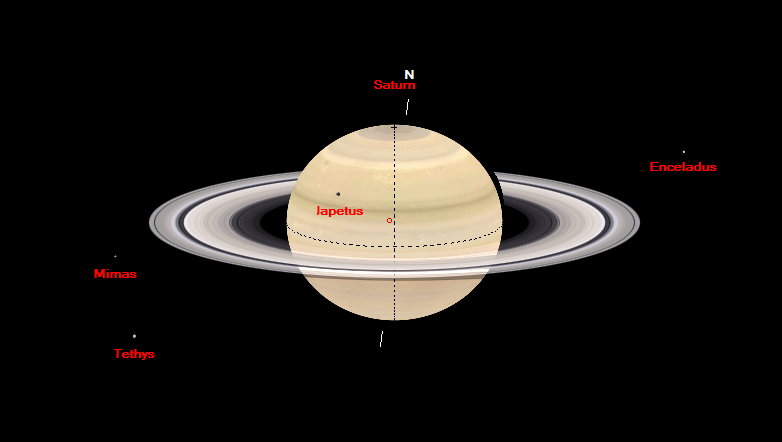2022 July 11
Observer’s Challenge – The Transit of Saturn’s Satellite Iapetus on 2022 July 17/18
On 2022 July 17/18, Saturn’s third largest satellite Iapetus, will transit across Saturn’s northern hemisphere and its rings. This will be preceded by a transit of this satellite’s shadow on July 17. The shadow transit will not be visible from the UK, but part of the satellite transit will be.
As can be seen below, each transit takes a number of hours to complete and so will be visible from a range of geographical locations. Observers can check if any parts of these events are visible from their own geographical location with the planet above the horizon and in darkness by using software such as WinJupos or Stellarium.
Transits (and indeed occultations and eclipses) of this satellite are rare but a number of such events are predicted for this year, as shown in the 2022 BAA Handbook (download for BAA Members only).
The predicted timings for the various transit events shown in Table 1 have been derived using the WinJupos software and should be used as a guide as these times may be approximate.
| EVENT | DATE | TIME (UT) | NOTES |
| Midpoint of ingress at the Nf. edge of Ring A. | July 17 | 21:25 | |
| Midpoint of ingress onto the Nf. limb of Saturn. | July 17 | 23:54 | Ingress is south of where Cassini’s division passes behind the planet. |
| Iapetus on the central median of Saturn. | July 18 | 04:42 | |
| Midpoint of egress from the p. limb of Saturn. | July 18 | 09:55 | |
| Egress from the p. edge of ring A. | July 18 | 15:56 | Slightly S. of the major axis of Ring A. |
Table 1. Approximate predicted timings for the transit of Iapetus across Saturn and its rings. 2022 July 17/18.
Figure 1 shows the predicted position of Iapetus plus some other satellites at 02:00 UT derived from the WinJupos software.

For UK observers, the transit across the rings will commence at the approximate time that Saturn rises above the SE horizon. Sunrise will occur before the satellite reaches the Central Meridian of the planet.
The last observations of such a transit made by BAA observers prior to 2022 were made on 2007 Jan 6/7 as reported in the Saturn 2006/2007 apparition report (JBAA Vol 120, issue 4, 2010) (link for BAA Members only).These may be the first observations of such an event recorded by the BAA.
The observers of this event were David Gray, Alan Heath and Dr. Richard McKim. Each observed visually but under difficult conditions. Alan Heath used the smallest aperture of the three (i.e. a 250mm Newtonian) and suspected a spot but at the correct location. Under better seeing, perhaps a slightly smaller aperture may suffice.
Imaging may also be used. Australian amateurs Darryl Milika and Pat Nicholas were able to successfully image a transit of this satellite earlier this year on April 29 using a C14 Schmidt-Cassegrain, as shown in Figure 2.

WinJupos simulations show for the shadow transit, the shadow will track across Saturn’s southern hemisphere. Extrapolating this track backwards implies the shadow will initially be projected onto the Sf. side of the rings before crossing the planet. However this phase is not obvious in the WinJupos simulations.
The earliest that this software shows the shadow is at approximately 09:50 UT when the shadow is projected onto the f. side of Ring A where it covers the Sf. limb of Saturn.
The shadow then tracks along the southern edge of ring A before being projected onto the ring shadow onto the globe. Subsequently, it is projected onto the planet itself, reaching the CM at approximately 14:33 UT. Shadow egress is at approximately 17:54 UT at the planet’s Sp. limb.
Given the rarity of this event, it is hoped that the skies are clear with good seeing during the times of each transit.
Any observations, both positive and negative can be sent into the Saturn Uranus & Neptune Section and posted on the BAA website.
Mike Foulkes, Saturn, Uranus and Neptune Section Director
| The British Astronomical Association supports amateur astronomers around the UK and the rest of the world. Find out more about the BAA or join us. |
